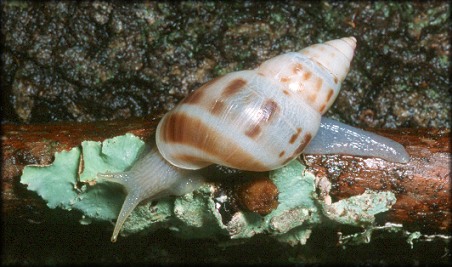On Tree Snails |
|
By Harry G. Lee |
| One doesn't normally
associate arboreal snails with northeastern Florida, but there
are no less than three species of land snails which have an
interesting predilection for life in trees.* In the case of Drymaeus dormani (W.
G. Binney, 1857) (pictured below),
this habit has been the source of great interest.
Sooty mold, although not a parasite on the orange tree, produces discoloration of fruits and probably impairs proper nutrition of heavily-affected plants by smothering the leaf surfaces. There is a measurable economic impact on orange growers, who must wash the fruits before shipping to minimize decay and maximize consumer appeal. Enter Dorman' s tree snail. Years ago naturalists observed that citrus groves "infested" with this lovely snail were "protected" from sooty mold from leaves, bark, and fruit without harming these parts of the trees. According to one source, "the trees that are cleaned stand out conspicuously from the surrounding trees by their bright foliage and clean trunks, (and) the fruit thus cleaned has a better color and probably ripens earlier." While some groves probably were naturally "attacked" by D. dormani, for many years these snails were purposely introduced into groves to the benefit of the oranges and growers. The more recent reliance on pesticides has overshadowed the use of tree snails (while probably killing these beneficial creatures indiscriminately). The future of the snail in orange groves is uncertain, but it may someday have a resurgence as man becomes increasingly aware of the environmental hazards, increasing costs, and only temporary effectiveness of chemical pesticides. What we will need is a biological control for the insect parasites of the orange which is as effective as the work done on sooty mold by our molluscan friend, Drymaeus dormani. * The other two species: Helicina (Olygyra) orbiculata (Say, 1818) and Mesodon thyroidus (Say, 1817) Literature cited: "The Manatee Snail Bulimulus dormani" Press Bulletin No. 59 Florida Agriculture Experiment Station Department of Entomology (Reprinted in Nautilus 20: 6-9, 1906 (May)) |
 Like its cousins, the Liguus,
D. dormani is found in association with the
saprophytic sooty mold which thrives best on smooth-barked trees.
Throughout much of its range (basically central Florida) D.
dormani is associated with citrus trees and it was
noted long ago that sooty mold kept company with the citrus
growers bane - the white fly. The larvae of these pests excrete
honey dew which encourages growth of the sooty mold of orange (Meliola).
The association between mold and fly larvae is so constant that
badly infested groves may be recognized at a distance by the
heavily-coated dark foliage.
Like its cousins, the Liguus,
D. dormani is found in association with the
saprophytic sooty mold which thrives best on smooth-barked trees.
Throughout much of its range (basically central Florida) D.
dormani is associated with citrus trees and it was
noted long ago that sooty mold kept company with the citrus
growers bane - the white fly. The larvae of these pests excrete
honey dew which encourages growth of the sooty mold of orange (Meliola).
The association between mold and fly larvae is so constant that
badly infested groves may be recognized at a distance by the
heavily-coated dark foliage.